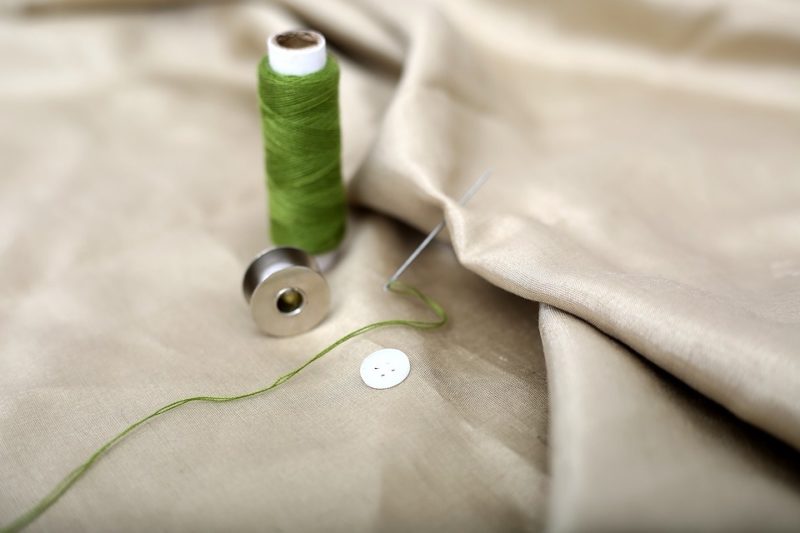There are two ways to learn how to backstitch on a sewing machine. Both methods include using the reverse button, but remember that every model will differ in how you backstitch with the machine.
This article will also discuss what you can do if your unit happens not to have this feature. And finally, you’ll learn the importance of backstitching in more detail.

How Do You Backstitch On A Sewing Machine?
As we’ve learned in how to reverse stitch on a Singer sewing machine, you don’t need to hold the reverse button to make the reinforcement stitches. Instead, locate the reverse button on your model or study your Singer manual as it has the sewing machine anatomy’s diagram.
Then, you only need to press the reverse button once after making the initial stitches and press it again to return to the setting that sews forward. Always consult your manual to know the reverse stitching instructions if you’re unsure.
Some sewing machine brands will require you to hold the backstitch button when sewing in reverse. For example, those who know how to backstitch on a Brother sewing machine will hold the reverse button as you’re pushing the pedal to make the reverse stitches.
Again, you can determine which method is suitable when backstitching with your unit by checking the manual. Otherwise, you may not make the correct stitches to reinforce your initial ones.
It’s also crucial that you practice on a piece of scrap fabric first when it’s your first time backstitching. That way, you’ll know the necessary adjustments before you work on your project.
You can still backstitch on a sewing machine even without a reverse button. Your model might be old since this setting is always common to modern models.
-
Fabric manipulation
So how can you sew in reverse without a backstitch feature on the sewing machine? Instead, you will manipulate the fabric yourself and turn it around.
You can proceed to sew forward from there, and the stitches will still be in the opposite direction. You can also stop at the end of the stitching line, raise the presser foot, and adjust the fabric backward for about three inches before sewing over the previous stitches.
-
Backstitch by hand
This way of backstitching is ideal if the seam is hidden since the stitches can look unappealing. But if this method does not apply to the project, you can backstitch by hand by leaving the thread ends loose after sewing with a machine.
-
Backstitching alternatives
Backstitching is the ideal way to finish your seams because it reinforces your work. But if the project won’t be subjected to stress anyway, you can tie a knot to secure the thread.
Read how to close a seam for more tips.
What Button Do You Push To Do The Backstitch On The Sewing Machine?
Always check your manual, as it will include the directions for backstitching. It will also show what the backstitch button looks like, often a button with a U-shaped arrow, indicating reverse.
Then, you only need to sew forward for three stitches, press the button and sew three stitches, and return to sewing forward. But as we’ve discussed earlier, take note if the sewing machine requires you to hold the reverse button or if you can release it while backstitching.
If your unit has a backstitch feature but doesn’t have a reverse button, it might use a reverse lever instead. You’ll push down the lever and leave it there to make backstitches and then raise it back to sew forward.
What Is The Purpose Of Reverse Stitching?
Reverse or backstitching is a crucial part of sewing because it secures your stitches, hence why it’s also called lockstitches. This will ensure that the project parts like the seams will stay durable and won’t unravel.
Uses of backstitching
- For securing the beginning and end of seam stitches
- Additional stitches in the middle of the seam when you rip some stitches
- For fixing fabric puckering when sewing on curves as extra security to the stitches
Is Reverse Stitching Necessary?
Reverse stitching secures the previous stitches, but it does not apply to all projects. Also, since the extra stitches can make that part bulky, it’s not advisable to backstitch on delicate fabrics.
Here is what to do instead:
- Shorten the stitch length to 1mm
- Work the short stitches half an inch at the start and end of the seam
- Return to your normal stitch length when working the middle of the seam
In some projects, simply tying the thread ends will suffice to finish your stitching.
Conclusion
And that’s it! We just discussed how to backstitch on a sewing machine, which is as quick as pressing the reverse button.
Every sewing machine will only differ on whether you’ll press the backstitch button once or hold it as you’re pressing the pedal to sew. But in some cases, you need an alternative to backstitching to secure your stitches.
We hope this was helpful. Leave us a comment if you have any.
